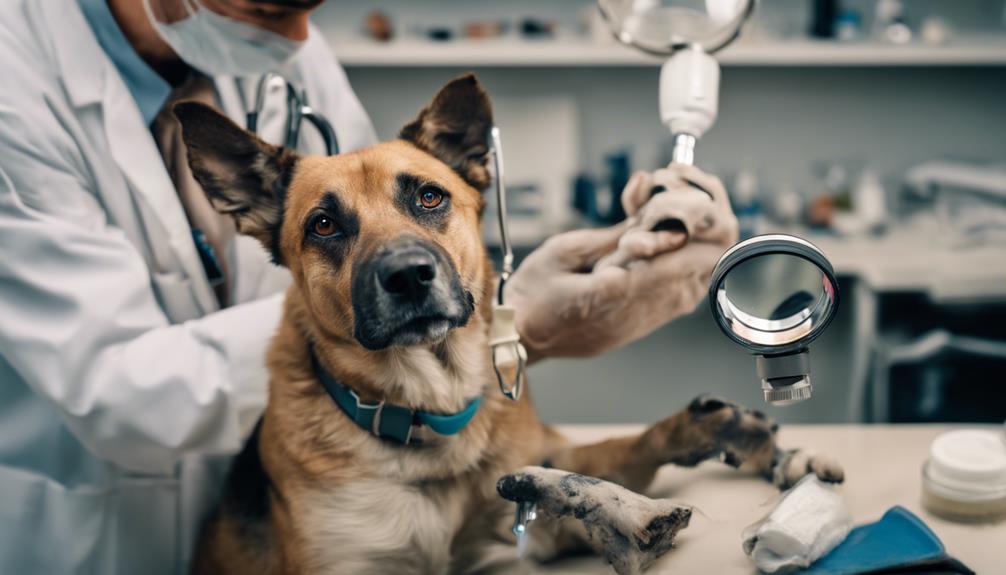How to Handle Canine Hyperpigmentation
- Advertisement -
If you've noticed darkened and thickened areas on your dog's skin, you may be dealing with canine hyperpigmentation, a common condition caused by various underlying factors like hypothyroidism, allergies, or skin infections. Recognizing symptoms is vital to identify the underlying cause, which may be related to conditions like hypothyroidism, allergies, or skin infections. Effective treatment options involve addressing the underlying cause, administering antibiotics and antifungal medications, and using medicated shampoos. By understanding the underlying condition, you can take steps to manage symptoms, prevent relapse, and promote recovery – and there's more to learn about handling canine hyperpigmentation.
Key Takeaways
- Identify the underlying cause of hyperpigmentation through a thorough physical exam, skin scraping analysis, and diagnostic tools.
- Address the underlying cause with effective treatment options, such as antibiotics, antifungal medications, thyroid supplements, and medicated shampoos.
- Manage symptoms with topical treatments like steroid ointments, anti-itch creams, and medicated shampoos, and monitor progress with regular veterinary check-ups.
- Prevent relapse and complications by maintaining a consistent skincare routine, addressing underlying causes, and adjusting treatment plans as needed.
- Factor in the cost of treatment, ranging from $200 to $800, and ensure pet insurance policies cover skin conditions, including hyperpigmentation.
Understanding Canine Hyperpigmentation
Hyperpigmentation in Dogs: What You Need to Know
When you examine your dog's skin, you may notice darkened and thickened areas that seem to appear suddenly. This condition, known as hyperpigmentation, is common in dogs and can occur in any breed. It's essential to understand that hyperpigmentation is not a disease itself, but rather a reaction to an underlying condition.
There are two types of hyperpigmentation: primary and secondary. Primary hyperpigmentation is rare and breed-specific, whereas secondary hyperpigmentation is more common and results from various underlying conditions, such as hypothyroidism, Systemic Lupus Erythematosus, allergies, Malassezia, and demodicosis.
Hyperpigmentation causes discoloration and thickening of the skin, appearing as pinprick-sized areas of rough, light brown or black skin. These areas can grow large and spread to other parts of the body, such as the legs, armpits, groin, lower neck, abdomen, ankles, rear end, eyes, or ears.
Recognizing the signs of hyperpigmentation is crucial to address the underlying condition and prevent further skin issues. By understanding canine hyperpigmentation, you can take the necessary steps to ensure your dog receives proper care and attention.
Identifying Symptoms and Causes
Monitor your dog's skin for darkened and thickened areas, often appearing as black spots or patches. These areas may be hairless, feel rough to the touch, and typically appear on the legs, armpits, or groin. Recognizing these symptoms can help you identify the underlying cause, which may be related to conditions such as hypothyroidism, allergies, or skin infections.
Symptoms to Watch
When examining your dog's skin, recognizing the symptoms of hyperpigmentation is crucial for identifying the underlying cause and seeking timely treatment.
Hyperpigmentation typically appears as darkened and thickened skin, often evident as black spots, splotches, or patches.
Common symptoms to watch for include:
- Discoloration: Small, rough areas of light brown or black skin that can grow large.
- Thickening: Skin thickening in areas like the legs, armpits, or groin.
- Redness: Red skin surrounding the affected area, which may indicate a skin infection.
- Size and growth: Monitor the size and growth of the affected area, as it can lead to more severe skin issues if left untreated.
Common Causes Found
Identifying the underlying causes of hyperpigmentation in your dog is crucial for effective treatment and management. Allergies can lead to hyperpigmented areas on the skin. Hypothyroidism is another potential cause, affecting up to 33% of dogs. Systemic Lupus Erythematosus is a common cause that requires a physical exam, medical history review, and diagnostic testing for diagnosis.
Yeast infections, such as Malassezia, often cause hyperpigmentation. Antifungal medications may be prescribed to treat the underlying infection. Demodicosis, caused by a mite, is a lesser-known cause of hyperpigmentation. It's diagnosed through skin scrapings and impression smears to identify the underlying parasite.
Diagnosing the Underlying Condition

To diagnose the underlying condition causing your dog's hyperpigmentation, you'll need to work with your veterinarian. A thorough physical exam is essential, providing valuable insights into your dog's condition. Skin scraping analysis can help rule out bacterial, yeast, or mite infections. By combining the physical exam findings with the skin scraping results, you can narrow down the possible causes and develop an effective treatment plan.
Physical Exam Findings
During a physical exam, look for signs of hyperpigmentation, including:
- Skin texture changes: Hyperpigmentation can cause skin to become thicker, thinner, or more fragile.
- Abnormal hair growth: Excessive hair growth or hair loss may indicate an underlying hormonal imbalance.
- Redness and inflammation: Areas of hyperpigmentation may appear red, swollen, or inflamed, suggesting an allergic reaction or skin irritation.
- Lesions or masses: Unusual growths or lesions can indicate an underlying skin condition or cancer.
When examining the dog, note the location, size, and appearance of any hyperpigmented areas, as well as any other signs of illness or discomfort. This information will help you determine the underlying cause of the hyperpigmentation and develop an effective treatment plan.
Skin Scraping Analysis
To diagnose the underlying condition causing hyperpigmentation, collect skin scraping samples from the affected areas. This process, known as skin scraping analysis, involves gently scraping the skin with a scalpel blade or skin scraper to collect cells and debris. The collected material is then examined under a microscope to identify any abnormalities.
In some cases, skin biopsies may be necessary to collect a larger sample of skin tissue for further examination. Impression smears can also be used to examine skin cells and debris more closely. These diagnostic tools help identify the underlying cause of hyperpigmentation, such as allergies, hormonal imbalances, or autoimmune disorders.
Analyzing skin scraping samples helps determine the best course of treatment for your canine patient. It's essential to perform a thorough skin scraping analysis to rule out other potential causes of hyperpigmentation and develop an effective treatment plan.
Ruling Out Infections
Ruling out infections is crucial in determining the underlying cause of hyperpigmentation in your canine patient. Skin infections, such as yeast and bacterial infections, can lead to hyperpigmentation. To rule out infections, you'll need to perform further diagnostic tests.
Four key tests can help identify infections:
Bacterial culture identifies bacterial infections on the skin.
Fungal culture detects fungal infections, like yeast, that contribute to hyperpigmentation.
Cytology examines skin cells to identify infectious agents.
In some cases, imaging studies like radiographs or ultrasound may be necessary to rule out underlying infections not visible on the skin's surface.
- Advertisement -
These tests will help you determine if an infection is the root cause of hyperpigmentation in your canine patient.
Effective Treatment Options
Effective treatment options for canine hyperpigmentation include addressing the underlying cause, administering antibiotics and antifungal medications, using medicated shampoos, and prescribing thyroid supplements for hypothyroidism. Medicated shampoos can be used two to three times a week, leaving the lather on the skin for at least 10 minutes before rinsing.
Severe cases may require injectable and prescription medications, such as allergy medication, steroids, and immune-changing drugs. Topical treatments like steroid ointments and anti-itch creams, sprays, wipes, or mousse can help in early stages. In some cases, a weight loss plan, including a special diet and exercise, may be necessary to address obesity, a common underlying cause.
Working closely with your veterinarian is crucial to determine the best course of treatment for your dog. They will help identify the underlying cause and develop a tailored treatment plan. With the right treatment and care, you can alleviate your dog's symptoms and improve their overall health and well-being.
Managing Symptoms and Recovery

Managing symptoms and recovery from skin issues in dogs takes time and patience. It can take weeks or even months for your dog's skin to return to normal. Follow-up appointments with your veterinarian are crucial to continue treating the underlying cause and monitor progress.
To aid in your dog's recovery:
Use medicated shampoos two to three times a week, leaving the lather on the skin for at least 10 minutes to effectively remove excess oil and odor.
Treat secondary hyperpigmentation based on its underlying cause, such as thyroid supplements for hypothyroidism or oral medications for Cushing's disease.
Regularly use medicated shampoos to remove excess oil and odor, as signs of hyperpigmentation resolve slowly.
Consider investing in pet insurance to help cover the cost of treatment, which averages $500, ranging from $200 to $800.
Preventing Relapse and Complications
To prevent relapse and complications, it's crucial to identify and address the underlying cause of your dog's hyperpigmentation. If left unmanaged, hyperpigmentation can recur and lead to further skin problems.
Regular veterinary check-ups are necessary to monitor your dog's progress and adjust their treatment plan as needed. These appointments help catch potential issues early, ensuring your dog's skin health stays on track.
Maintaining a consistent skincare routine is also vital. This includes using medicated shampoos and ointments to prevent hyperpigmentation from coming back. A consistent routine helps keep your dog's skin healthy and reduces the risk of complications.
Cost and Insurance Considerations

The cost of treating canine hyperpigmentation can vary, but it's essential to factor it into your dog's healthcare budget. On average, treatment costs around $500, ranging from $200 to $800. However, this cost can vary depending on the underlying cause of the condition, with more complex conditions requiring longer and more expensive treatment plans.
To prepare for the financial burden, consider the following cost and insurance factors:
- Check your pet insurance policy to ensure it covers skin conditions, including hyperpigmentation. Some policies may not cover pre-existing conditions.
- Regular veterinary check-ups can help identify hyperpigmentation early, reducing the overall cost of treatment.
- Verify that your policy covers the full range of treatment options, including medication, surgery, and alternative therapies.
- Enroll your dog in a policy as early as possible to provide coverage for hyperpigmentation and other skin issues.
Having an inclusive insurance policy can help alleviate some of the financial stress associated with treating canine hyperpigmentation. By factoring the cost of treatment into your dog's healthcare budget and considering these key insurance factors, you can ensure your dog receives the best possible care without breaking the bank.
Frequently Asked Questions
How Do I Fix My Dog's Hyperpigmentation?
To fix your dog's hyperpigmentation, start by consulting with your veterinarian to determine the underlying cause. They may recommend skin scraping to rule out underlying infections, such as mange or ringworm. Dietary changes can help reduce inflammation, so your veterinarian may suggest a specific diet or supplements. Topical treatments, like medicated shampoos and ointments, can manage symptoms. However, it's crucial to address the root cause to effectively treat hyperpigmentation. Based on your dog's specific needs, your veterinarian will develop a comprehensive treatment plan, which may involve a combination of these approaches.
How Long Does It Take for Hyperpigmentation to Fade in Dogs?
The time it takes for hyperpigmentation to fade in dogs varies depending on several factors, including genetics, skin tone, and age. Generally, it can take weeks to months for the skin to return to its normal state.
Treatment and follow-up appointments also influence the duration of the process. The cost of treatment is another factor to consider.
While patience is necessary, the right treatment can help your dog's skin regain its natural appearance.
What Cream Is Good for Hyperpigmentation in Dogs?
Topical creams can help address hyperpigmentation in dogs. To find an effective cream, look for ingredients like hydrocortisone, kojic acid, and vitamin E, which have been shown to reduce hyperpigmentation. Before making a purchase, consult with your veterinarian to determine the best cream for your dog's specific needs. They can recommend a suitable treatment and ensure it's used correctly.
Is Hyperpigmentation Permanent in Dogs?
In dogs, hyperpigmentation is often not permanent. Only 20% of cases result in permanent discoloration. However, it's crucial to identify and address the underlying causes, such as breed predisposition or skin lesions, to prevent further damage. If left untreated, the condition can lead to permanent discoloration. By managing the root cause, you can help your dog's skin return to normal, which may take weeks or months.
In summary
Canine hyperpigmentation is a common condition that affects up to 40% of dogs. Timely intervention and proper care can significantly improve your dog's quality of life.
To manage hyperpigmentation, it's essential to stay informed and proactive. This condition can occur at any point in a dog's life, and prompt action can make a big difference.
By understanding the causes, symptoms, and treatment options, you can help your dog thrive despite this condition. In this article, we'll provide you with practical guidance on how to handle canine hyperpigmentation and improve your dog's well-being.
- Advertisement -

